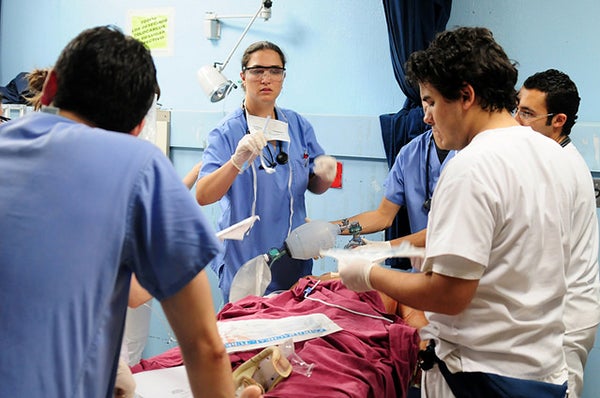
As I was flying to Brazil recently to learn more about the country’s Programa Mais Medicos (PMM, or the “More Doctors” program) , I tried to visualize 11,000 Cuban doctors newly recruited to Brazil, standing side-by-side, armed with their white coats, stethoscopes and big smiles in the open plains of the Sertão Nordestino.
Clearly. It would make a big impression -- you could probably see them from the moon --but would it be enough to improve health care in Brazil? And even if it was, would it be sustainable?
I had studied the Brazilian family health program (FHP) a decade ago. It is an ambitious effort to improve and modernize primary health care in a country that combined poor health indicators with an emphasis on hospital services. During its first few years, using teams that combined doctors, nurses and community health agents, the FHP managed to cover 100 million Brazilians (half of the population), mostly in the poorer municipalities, and achieve measurable impact on basic health indicators.
I hadn’t kept track of events in Brazil, but I knew that coverage of FHP had stagnated. I also remembered reading that, in 2013, there had been massive demonstrations protesting against poor quality of public services, including health care. But how was PMM faring now?
My discussions in Brazil provided a few enlightening answers.
Programa Mais Medicos (PMM)
The PMM faces a big challenge of mobilizing thousands of doctors to serve 4,000 municipalities (including all of the special health districts for indigenous populations). According to official statistics, the program has improved coverage for 63 million Brazilians, increasing consultations and reducing unnecessary hospitalizations, and surveys find high levels of user satisfaction.
The program has three components: an investment component, an “emergency component” (involving foreign doctors), and a training component aiming to reform the country’s medical training system. Implementing each of these components requires overcoming big obstacles. Only by looking at the components together in the context of Brazil’s health system is it possible to understand its ambitious vision and the way Brazil has learned from past mistakes.
Capital investments
The capital investment component involves investments in infrastructure, equipment, telemedicine and information systems for basic health. The numbers are impressive: 15,000 clinics were improved, 8,000 new clinics were built, and 45 river ships were adapted as hospitals in 4,900 municipalities, at a cost of around US$1.5 billion.
To understand the magnitude of this, compare these numbers with those of a neighboring country, which has struggled during the last 4 years to keep an electoral promise of building 170 basic hospitals; as the presidential term is coming to an end, fewer than 50 have opened. In Brazil, investments were funded largely by the federal government but implemented by municipalities. This set-up required new legislation designed to ensure high quality of public investments using flexible blueprints and fiduciary procedures; it also required establishing political agreements with mayors of different political parties.
Deployment of doctors
PMM’s emergency component --involving the hiring and deployment of over 18,000 doctors-- has attracted a lot of attention. While Brazilian candidates are given priority in the program, very few Brazilians applied to participate in PMM’s first two years. As a result, 85% of participating doctors are foreigners from various countries (including the 11,000 Cuban doctors). According to the implementers, Brazilians have now become interested in the program, and they make up a majority of 2015 recruits.
Reforming medical training
The training component involves a reform of medical training. In the early 2000s, Brazil tried unsuccessfully to reform its medical residency system – a crucial stage in the training of physicians that defines their specialty and interests. A big effort was then made to create primary care residencies in the cities where the best medical schools are located. It failed (only 19% of vacancies were filled!) because it could not compete with the more prestigious specialist residencies offered by the same medical schools.
Attempts at legal reform were also blocked because medical training (which includes a large fraction of the budget of the most influential hospitals) falls under the Ministry of Education and is regulated by legislation, institutions and interest groups that are independent from the health policy priorities of the Ministry of Health.
PMM is using these lessons in a new attempt to reform medical training. An especially interesting element of the reform was developed in response to criticism from the Brazilian medical establishment, which argued that foreign doctors should take the Brazilian medical licensing exam to protect the safety of patients (though Brazilian medical schools themselves do not routinely submit doctors to licensing exams). To overcome this objection, Programa Mais Medicos was developed as a training program: participating doctors (even if they have many years of experience) are recruited as on-the-job trainees working for a 3- year period under the supervision of a specialist.
This may end up being one of the most important contributions of the PMM. Doctor trainees are helping to jump-start a functioning primary care residency program in underserved regions of Brazil, with supervision by some of the best universities in the country and open to local students. This combination is expected to lead to higher retention in primary care jobs in those locations.
In addition, the ambitious reform program requires all medical students to train in primary care before becoming eligible to take residences programs in other areas. Together with sticks, there are plenty of carrots, and professionals that complete a family medicine residency will receive points for further specialization and for public employment.
Emergency measures for the future
The so-called emergency component of PMM may also have long-lasting effects through the creation of a federal program capable of solving two problems that have haunted the country’s family health program for over a decade.
First, primary care is a municipal responsibility requiring thousands of mayors in distant poor municipalities to compete with urban hospitals and with private health providers to hire family care doctors. This fragmented market has led to very high salary promises that often cannot be sustained. The new program replaces this fragmented market by a federal system capable of prioritizing locations of high need.
Second, historically, family health program contracts were developed using gimmicks designed to get around civil service practices and legal “fiscal responsibility” rules that cap the hiring of public employees. These contracts were a useful temporary response to impediments, but were not developed as an organic solution offering a career path or to provide solutions to disincentives associated with distant locations.
PMM is creating a permanent vehicle to replace the fragmented labor market with a system capable of allocating doctors according to national priorities. It also may transform previous ad hoc arrangements into part of a career path for future health professionals.
Are there risks?
After learning more about the PMM, my main concern with this model centers on fragmentation of the monitoring and evaluation of the program. There are many pieces that need to work to make the program sustainable. While my colleagues and I were assured that there are many initiatives to monitor the impact of the program, we left Brazil with the impression that there is no plan to monitor and report on progress for the program as a whole (including the sensitive training and infrastructure components).
Also, perhaps too much of the evaluation will be done by the implementers instead of by an external party. Without strong monitoring and an open discussion, Brazil may lose the opportunity to correct problems as they arise, and the opportunities opened by 11,000 Cuban doctors may be missed.
Follow the World Bank health team on Twitter: @WBG_Health
Related
Human Resources for Health Brief
World Bank and Health
World Bank and Brazil


Join the Conversation